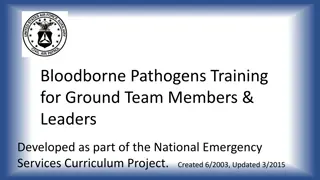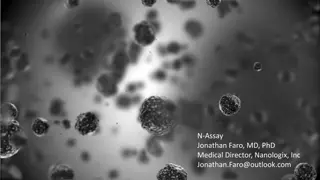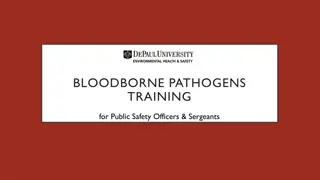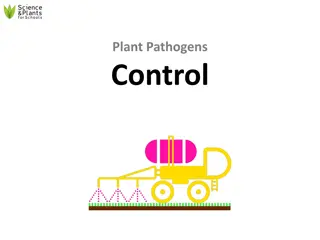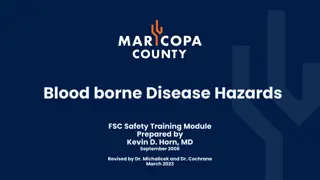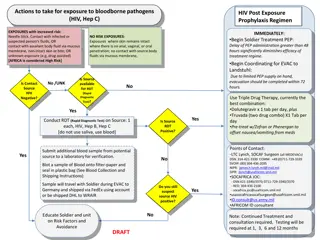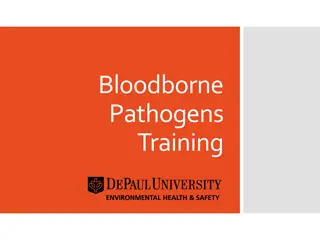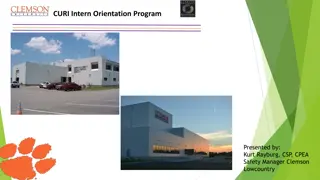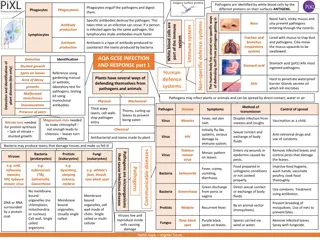Understanding Bloodborne, Airborne, and Droplet Pathogens in Workplace Training
Explore the importance of annual training for employees in contact with blood or blood products, as mandated by OSHA. Learn about occupational exposure, exposure control plans, disease processes, and types of diseases caused by microorganisms. Gain insights into normal flora, infectious diseases, and communicable diseases in the workplace setting.
Download Presentation

Please find below an Image/Link to download the presentation.
The content on the website is provided AS IS for your information and personal use only. It may not be sold, licensed, or shared on other websites without obtaining consent from the author. Download presentation by click this link. If you encounter any issues during the download, it is possible that the publisher has removed the file from their server.
E N D
Presentation Transcript
Bloodborne, airborne and droplet pathogens SCARBOROUGH FIRE DEPARTMENT ANNUAL TRAINING 2022
Whats this all about?! OSHA 1910.1030- any employee that may come in to contact with Blood or Blood products must attend yearly training. Additional education is required each time there is a change in procedure Training is site specific
What is Occupational Exposure OSHA Defines Occupational Exposure as a reasonably anticipated skin, eye, mucus membrane or parenteral contact with blood or other potentially infectious material that may result from the performance of an employees duty Not the same as an EXPOSURE Incident, an Exposure incident is a specific incident in which someone has been exposed
Exposure Control Plan Updated yearly by the Designated Infection Control Officer. Annual training must cover the updates Located on SFD Training Website, Google Operations Page, Captain s Office, Deputy's Office, Administrative Office and in Human Resources at Town Hall. The plan covers Universal Precautions, Engineering controls, work restriction and post exposure follow up.
Disease Process Causes of Disease Microorganisms that are carried in human blood or body fluids Normal Flora- assist the body as a natural defense to maintain health by preventing harmful bacteria from growing Bacteria- Need certain conditions to grow but can survive out side the human body Virus- A packet of genetic material that is surrounded by protein covering, unable to grow or reproduce out side a living host. Prion - A disease-causing agent that is not bacterial, fungal, or viral and contains no genetic material.
Disease Process Type of Disease Infectious- Illness resulting for Bacteria, virus, fungi, prion or parasite. Communicable- A disease that is readily spread from one person to another under certain conditions. Vector - An organism, such as an insect or animal that transmits disease-carrying germs.
NORMAL FLORA Microorganisms (usually bacteria) are found on healthy human body surfaces Each body site has its own normal flora
Disease Process Risk of transmission Primary comes from blood, vaginal secretions and semen only a risk in sexual contact. Secondary- Fluid from joints, around the heart, abdomen, spinal fluid and other body fluids that contain VISIBLE blood. Not a risk for transmission, Urine, Fecal matter, Vomit, tears, Unless they contain VISIBLE blood.
Disease Process How is disease spread? (Disease Vector) Direct Contact- Direct contact of infected blood with blood form another person Example- You apply pressure to a person who has a laceration to an artery in their leg. During the transfer of the patient to the backboard you cut your forearm and the patients blood get on your arm. Indirect Contact- Spread from a person to an object and than to another person Example- You are working a MVC, when moving the patient you get cut by glass that has the patients blood all over it. Example 2- A person has Norovirus and drinks from a glass. Then you drink from the same glass and contract the virus.
Assessing the risk of exposure Four factors to consider Organism Each organism has a specific mode of entry Dose of the Organism Number or organism present in exposure, Each disease has a number requirement, If there is no Disease present, infection cannot occur. For Viruses, this is known as Viral Load. Host resistance to Organism The healthier you are, less chance for infection Strength of the Organism * (Virulence) Strength outside vs. inside the body. HIV and TB do not survive in air and light
Assessing the risk of exposure Bodies Natural Defenses Skin- First line of Defense Conjunctiva- Protects the eyes by the motion of the eyelids and tears. Lungs- Cilia, mucous membranes, cough mechanism GI Tract- Acid of gastric juices and bile secretions Immune System- resistance for infection Factors that compromise resistance Smoking, Age, Drug use, Trauma, Malnutrition, chronic diseases.
Exposure Incidents Contact with skin: wash exposed areas with antimicrobial soap and running water Contact with eyes or mucous membranes: flush affected area with running water for at least 15 minutes Contact with clothing: remove contaminated clothing, wash underlying skin with antimicrobial soap and running water. Be careful not to spread the contamination. (Note, it is best to initially wash with cold water until visible contamination has been removed). This keeps the pores in the skin closed.
Exposure Incidents Contact the Designated Infection Control Officer at 730-4297, Someone is on call 24/7 The DICO will make exposure determination If deemed an exposure, source testing will be requested. If source is negative, no further testing or evaluation is needed If Source is positive, follow up testing of the employee will take place if vaccination history is not on file or insufficient. Any information obtained in regards to the Source Disease status must be kept confidential, failure to do so may result in civil liability Follow up will be confidential and results will not be known by the Department.
Bloodborne, airborne and droplet diseases
Hepatitis B (HBV) Transmitted by blood to blood contact, sexual contact and indirect contact. 2006 CDC reported that HBV in public safety lower than general public Signs and symptoms will begin like a flu like illness and may progress to jaundice, fatigue, abdominal pain, dark urine, whitish stool and smokers often lose interest in smoking 6.0-30.0% risk of infection if from Source positive needle stick and not vaccinated 50-60% of people do not know they are infected with the disease
Hepatitis B (HBV) This disease can be prevented Two vaccines available, Recombivax and Engerix. Low risk of side effects. May include low grade fever, soreness at injection site Has been used since 1982 Offered to each employee at no cost Vaccine only good for HBV and will not protect against other types of Hepatitis. Series consists of 3 doses, First shot, 2nd shot 4 weeks later, 3rd shot 6 months after the first. Titer within 2 months of last shot, may need to repeat the series if you did not respond to the vaccine. If you chose to decline vaccination, Declination form must be signed.
Hepatitis C (HCV) Transmitted by Blood to Blood Contact, blood transfusions, needle stick injuries, Sexual contact Tattoos and body piercings are factors that increase the risk 15-30% Sexual Contact 15-20% IV Drug users is the highest risk group 42% Incubation period 6-7 weeks Signs and symptoms are much like HBV, Flu like illness, loss of appetite, headache and nausea 5 studies show that Fire/EMS personnel are at no Increase risk
Hepatitis C (HCV) No Vaccine available, post exposure treatment is counseling, post exposure testing HCV-RNA at 2 weeks Rapid test available to know source status in 23 minutes. There is effective treatment where 75-95% of people have been cured. 1 Transmission via splash into the eyes and 1 via non intact skin. Treatment consists of 3 drugs-Interferon, Ribavirin and 1 other. And is covered under workers comp
Human Immunodeficiency Virus (HIV) Virus which attacks the bodies immune system and its ability to fight infection Virus progress to AIDS Transmission primarily sexual contact-M/M, M/F, F/M Second is IV drug users sharing needles and syringes Third is mother to Infant (1-3%) Smaller numbers consist of Blood Transfusions and needle stick injuries, 57 Health care workers have documented and acquired infections, none since 2001.
Human Immunodeficiency Virus (HIV) HIV is not a highly infectious disease Does not survive out side the body Donated blood screened for p24 (closes the window phase to 1-6 days) Higher Risk exposures: Deep puncture injury Visible blood on device HIV CELL Device had been in patients vein or artery, not iv tubing Patient HIV positive with High Viral Load Large gauge (18+) hollow bore needle
Human Immunodeficiency Virus (HIV) Post exposure Test source patient, if source negative, no further testing of staff needed Source positive- Must conduct viral load testing, Viral load above 1500 copies/ml, considered high. 96% Patient receiving antiviral drugs and responding to treatment with low viral load, are unable to transmit the disease Rapid testing available, 10-20 minutes to know results. Must know source status to indicate Post Exposure Prophylactic treatment (PEP) If PEP is indicated, counseling must be conducted on drug interactions, side effects, pregnancy, CBC, LFT etc. Risk date: Sharps injury 0.3% Mucus Membrane 0.09% Non Intact skin 1 case in studies (1999)
Syphilis Disease caused by bacteria Cases in the United States are on the rise, mostly males. Primarily a sexual transmitted disease, but direct blood to blood contact may pose a transmission risk High risk groups include IV drug users, prostitutes, HIV positive and HVC positive persons. Signs and symptoms Syphilis Rash Primary lesion or chancre may appear 3 wks after exposure 4-6 weeks rash on soles of feet and palms of hands may occur. May progress in to latent phase if not treated. Treatment consists of Long acting PCN
Corona Virus (Covid-19) COVID-19 is thought to spread mainly through close contact from person to person, including between people who are physically near each other (within about 6 feet). People who are infected but do not show symptoms can also spread the virus to others. Respiratory droplets can also land on surfaces and objects. It is possible that a person could get COVID-19 by touching a surface or object that has the virus on it and then touching their own mouth, nose, or eyes. COVID-19 affects different people in different ways. Infected people have had a wide range of symptoms reported from mild symptoms to severe illness.
Tuberculosis (TB) TB Is caused by a bacteria not a virus Spread by droplet which are expelled by an infected person TB Is not a highly communicable disease Risk for exposure is based on time with infected person, if ventilation was present and any prevention measures that were used Exposure time is between 2-10 hours in an unventilated confined space.
Tuberculosis (TB) TB Infection- Positive on test but no Disease, cannot pass on disease. No need for repeat testing or yearly chest x-rays unless you develop symptoms. TB Disease- Positive test, Positive x-ray, positive lab data. May be able to pass disease on. If following an exposure you test positive, you may be offered a drug treatment lasting 6-9 months Symptoms include Cough >3 wks Plus two of the following Weight loss, night sweats, swollen lymph glands, chest pain, hoarseness.
Tuberculosis (TB) New complication Multi drug Resistant TB (MDR-TB) Does not respond to drugs that are currently used Mostly seen in Immunocompromised persons/immigrants Still many drugs available to treat this Extensively Resistant TB (XDR-TB) Resistant to 2 most common antibiotics plus two injectable antibiotics About 4% of MDR-TB are now XDR-TB Still is treatable and not more infectious MAINE EMS PROVIDERS ARE CONSIDERED LOW RISK!! Therefor EMS does not require annual PPD testing
Seasonal Flu (Influenza) Influenza (flu) is a contagious respiratory illness caused by influenza viruses. It can cause mild to severe illness. Serious outcomes of flu infection can result in hospitalization or death. Some people, such as older people, young children, and people with certain health conditions, are at high risk of serious flu complications. The typical incubation period for influenza is 1 4 days (average: 2 days). Most healthy adults may be able to infect others beginning 1 day before symptoms develop and up to 5 to 7 days after becoming sick.
Seasonal Flu (Influenza) Continued Flu-like symptoms include fever, cough, sore throat, runny or stuffy nose, body aches, headache, chills and fatigue. Some people also may have vomiting and diarrhea. People may be infected with the flu, and have respiratory symptoms without a fever (CDC). The flu virus can live on some surfaces for up to 24 hours. (Keyboard, Door handles Etc. CDC suggests that healthcare professionals receive he flu vaccine annually. (Unless there are medical contra-indications)
Tick and Mosquito Borne Diseases
Tick Borne Diseases Anaplasmosis Babesiosis Ehrlichiosis Lyme Powassan Encephalitis Rocky Mountain Spotted Fever Click on the Disease Name for a link to Maine CDC s Information Please visit the link below for Tick Borne Disease Prevention http://www.maine.gov/dhhs/mecdc/infectious- disease/epi/vector-borne/lyme/tick-prevention.shtml
Mosquito-Borne Diseases Dengue Chikungunya Eastern Equine Encephalitis Malaria West Nile Virus Yellow Fever Zika Click on the Disease Name for a link to Maine CDC s Information
Mosquito-Borne Disease Prevention Wear insect repellent: Yes! It is safe. When used as directed, insect repellent is the BEST way to protect yourself from mosquito bites even children and pregnant women should protect themselves. Higher percentages of active ingredient provide longer lasting protection. DEET: Products containing DEET include Cutter, OFF!, Skintastic. Picaridin (also known as KBR 3023, Bayrepel, and icaridin): Products containing picaridin include Cutter Advanced, Skin So Soft Bug Guard Plus, and Autan outside the United States). Oil of lemon eucalyptus (OLE) or PMD: Repel contains OLE. IR3535: Products containing IR3535 include Skin So Soft Bug Guard Plus Expedition and SkinSmart. Cover up: When weather permits, wear long-sleeved shirts and pants. Keep mosquitoes outside: Use air conditioning or make sure that you repair and use window/door screens.
Measles Transmission Airborne disease Direct contact with respiratory secretions Incubation period 7-18 days Different Name Hard Measles Red Measles Nine day Measles
Measles Symptoms Fever Rash Coryza Cough Koplik Spots (buccal mucosa) Conjunctivitis Prevention Mask the patient Use gloves Vaccinate
Mumps Mumps is an inflammation of the salivary glands Transmission Direct contact with respiratory secretions Face to face contact > 5 minutes in the same room If exposed and no immunity- work restriction is from day 12- 26 following exposure Signs and symptoms Fever Swelling of Salivary Glands Orchitis an inflammation of testicles (unilateral)
Mumps Prevention Vaccination 2 doses 1 month apart If you cannot show documentation of immunity- Vaccinate, a titer is not required Vaccine Live virus Cannot give to pregnant women Not effective post exposure. If received vaccine prior to 1967, must revaccinate
Rubella Rubella is a virus, also know as German Measles or the 3 day measles Transmission Face to face contact Prevention Signs and symptoms Vaccinate Low grade fever Place surgical mask on the patient Rash Coryza Place surgical mask on your self if not possible to mask patient Headach Incubation period 14-23 days
Chickenpox (varicella) Varicella Zoster is chickenpox and Herpes Zoster is shingles Transmission Face to face contact > 5 minutes of contact Contact with draining lesions
Chickenpox (varicella) Signs and Symptoms Lesions on covered areas of the body Fever photosensitivity Prevention Vaccination Place a surgical mask on the patient Place mask on yourself if not able to place on patient Vaccine Live Virus 2 doses,1 month apart Incubation Period 10-21 days following exposure
Pertussis (Whooping cough) Pertussis is a highly contagious bacterial disease that causes uncontrollable, violent coughing Initial symptoms, similar to the common cold, usually develop about a week after exposure to the bacteria.
Meningitis Can be a bacteria or virus Viral meningitis not an exposure risk, generally resolves with out specific treatment 90% of cases are viral Bacterial meningitis is communicable Bacterial meningitis is serious- can result in Brain damage Hearing loss Limb amputation Death Transmitted by exchanging respiratory and throat secretions (saliva or spit) during close (for example, coughing or kissing)
Meningitis Exposure Unprotected mouth to mouth Suction/intubation with no use of PPE Prolonged contact >8hr like with air travel Prevention Incubation Period is 2-10 Days Mask the patient If unable than mask yourself Post exposure-Rifampin or Cipro Vaccinate Children College Teens
Seasonal Influenza Transmission Droplet produced by coughing, poor hand hygiene Prevention Hand washing Viral infection that spreads easily form person to person Cough Etiquette Mask the patient Three types of seasonal influenza- A, B, C. Seasonal Influenza vaccine Only type A & B are included in vaccine
Seasonal influenza Vaccine Many different types available Healthcare considered High risk CANNOT CAUSE THE FLU Trivalent Signs and Symptoms 2 influenza A and influenza B Fever or chills Cough Quadrivalent Sore throat 2 Influenza A and 2 Influenza B viruses Runny Nose Muscle or body aches Headaches Vomiting, diarrhea
MRSA Staph is commonly found in the nose and skin in health people. Staph can lead to serious infections in surgical wounds, bloodstream and pneumonia. Risk factors Severity of illness Underlying diseases such as chronic renal failure, insulin dependent DM, peripheral vascular disease, dermatitis and lesions Invasive procedures such as dialysis, invasive devices (central lines, ports) urinary catheters Repeated contact with healthcare system (hospitalizations, nursing homes) Previous Hx of colonization
MRSA Transmission occurs when EMS providers contact sites of infection or common areas such as stethoscopes, door knobs etc. that have contaminated surface. Hands of personnel are the most common mode of transmission
Ebola (Hemorrhagic fever) The virus spreads by direct contact with body fluids, such as blood, of an infected human or other animals. The viral load is the highest when a patient has just expired. Signs and symptoms typically start between two days and three weeks after contracting the virus. Early Signs and Symptoms include fever, sore throat, muscle pain, and headaches. Later Signs and Symptoms include vomiting, diarrhea and rash, bleeding internally and externally. After 21 days, if an exposed person does not develop symptoms, they will not become sick with Ebola.
Ebola (Hemorrhagic fever) No specific approved FDA vaccine for the virus is available, although a number of potential vaccinations are being studied. People who care for those infected with Ebola should wear protective clothing including masks, gloves, gowns and goggles. The virus is able to survive on objects for a few hours in a dried state, and can survive for a few days within body fluids




